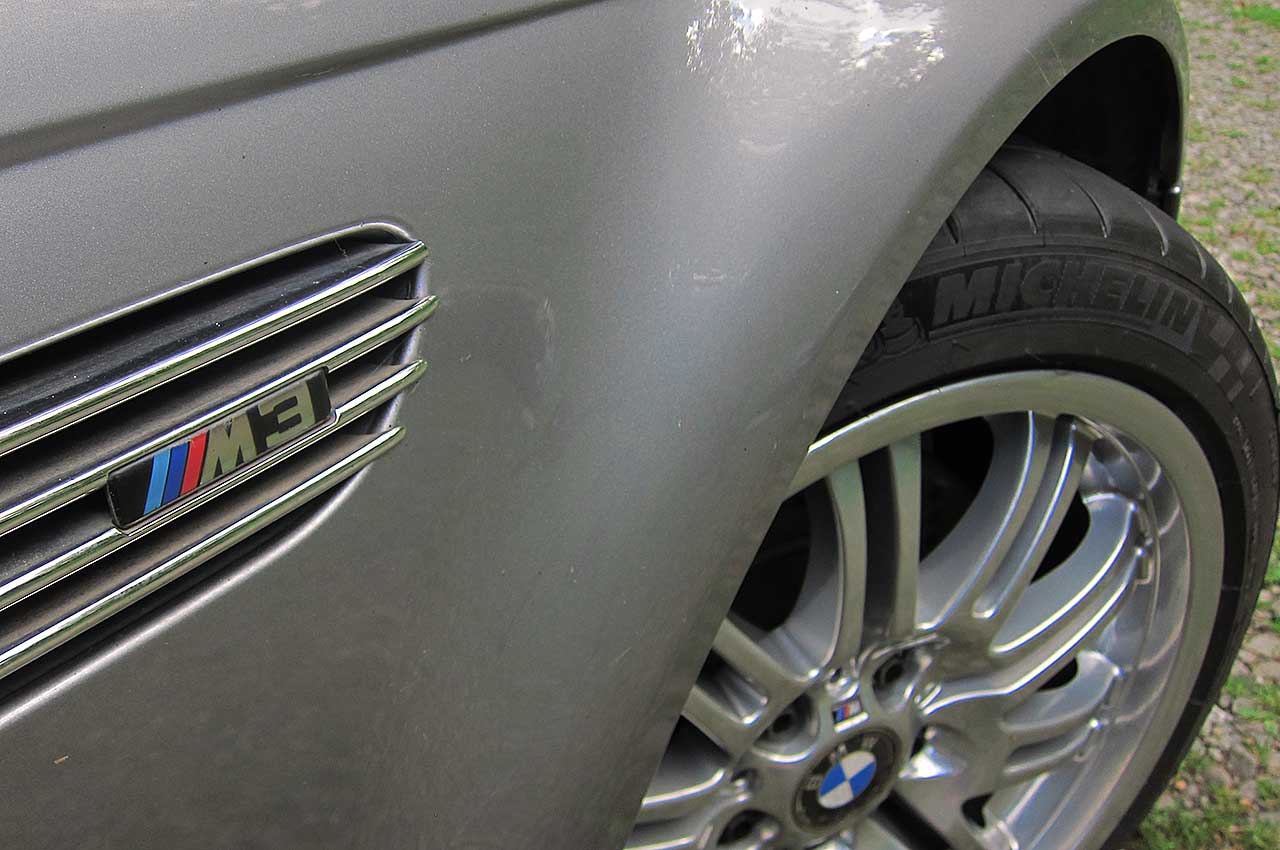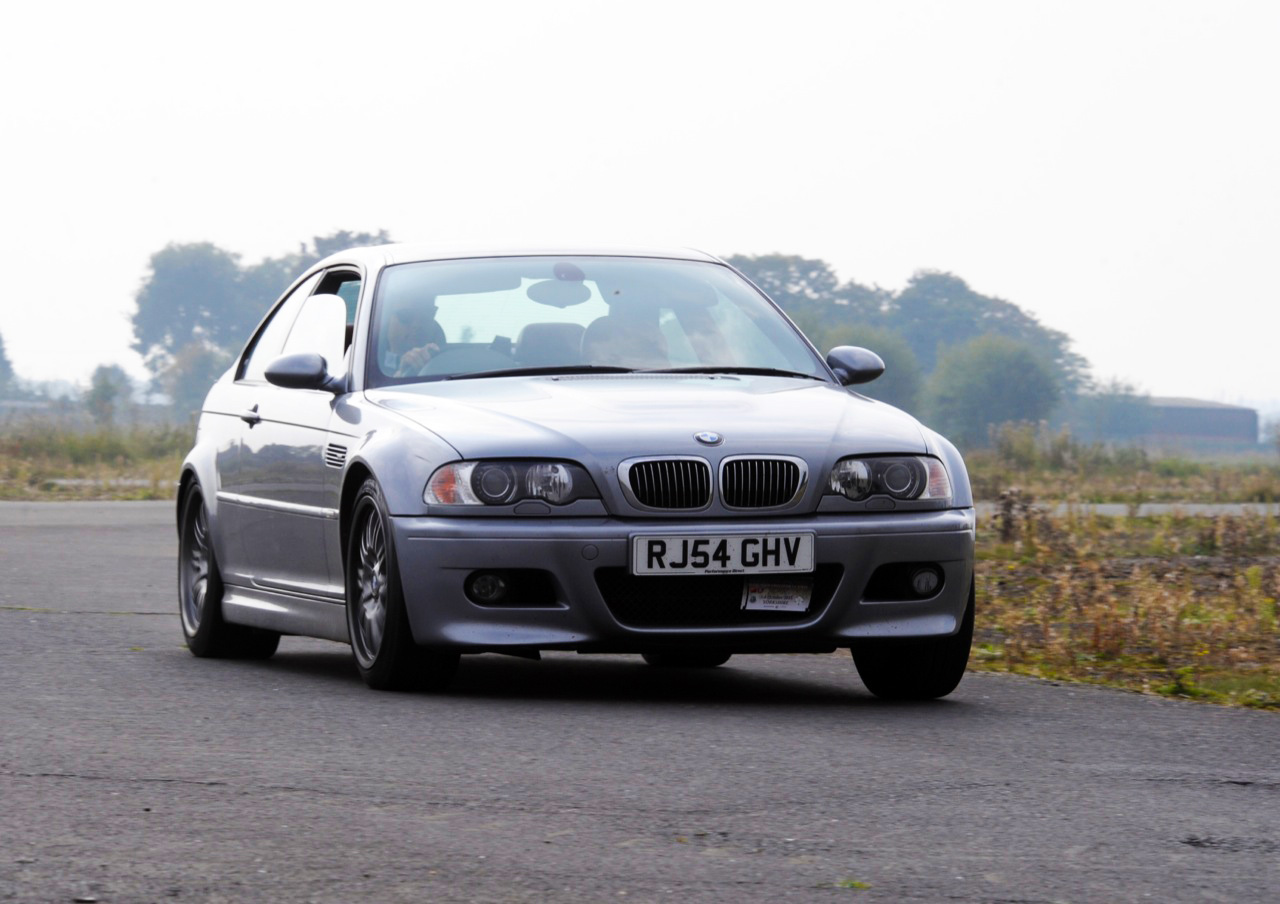Three years and 25,000 miles into ownership of my E46 M3 I’m still finding out things about it. Mostly what I’ve found out is that it’s immensely capable and a hoot to drive, but here are a bunch of other things that I never realised I didn’t know.
1 They all have manual gearboxes (even the automatic ones)
Manual M3s had a six-speed Getrag Type D gearbox and a 3.62:1 final drive. The SMG version wasn’t a conventional automatic – in fact it used exactly the same Getrag gearbox and the same final drive ratio as the manual car. The difference was that the SMG version had a layer of electrohydraulic sophistication added on to operate the clutch and change gear in as little as 80 milliseconds. BMW’s more recent M-DCT dual-clutch transmission is no quicker.
2 The bonnet is aluminium, but the wings are steel
The front wings and bonnet are both specific to the M3. While the bulged bonnet is aluminium alloy to save weight, the front wings are steel. You’d have thought BMW would make alloy wings as well, but they didn't – there must have been a reason why they stuck with steel even on the lightweight M3 CSL.

Alloy bonnet, but unique-to-M3 front wings are steel.
3 The facelift didn’t change things much
E46 3-series BMWs were given a facelift for the 2004 model year, most noticeably with a restyled front end. The giveaway is the shape of the indicators: the pointed end moved from the bottom to the top, and the front wings were reshaped to suit. But the M3 didn’t get the facelift front end, no doubt to save the cost of tooling up for two new front wings that would only ever be used on one model and then only for a couple of years before the E9x took over. The M3 did get the wider bootlid handle and LED rear lights that came with the E46 facelift, and there were minor changes inside – the SMG model lost its interior badging and the neutral indicator on the dash changed from 0 to N.
4 There’s something strange about the brakes
Actually there are two interesting things about the brakes. Unusually, the front brakes use ‘compound’ discs made of two materials – the centre bell is aluminium alloy for low weight and good heat dissipation, while the flat working section is of grey cast iron. Also unusually, the front discs are actually smaller than the rears – 325mm diameter compared to 328mm.
5 The American M3 was different – but not far off
US buyers of the previous-generation M3 got a half-way house amalgam of regular 3-series and M3, with a different engine and a lot less power. Stateside E46 M3 buyers were luckier: the US-spec S54 engine was only a fraction down on power compared to the Euro version (333hp against 338bhp) though it also made do with non-drilled brake discs.
6 The aero is more, and less, sophisticated than you think.
The original M3 concept, displayed at the Frankfurt motor show in 1999, had no bootlid spoiler – but one was added before the production car was released. Supposedly it’s functional, but it’s very small. I wonder if it really does anything at all, not least because the front wing vents don’t do anything: they were added because there was some concern that underbonnet temperatures would be too high but it turned out they weren’t needed. There’s no aperture in the inner wing for the vents to breathe through, so they do nothing.

Wing vents look good, but don't do anything.
7 That extraordinary engine was hand-built
The overall International Engine of the Year Overall winner in 2001 and winner in its class from 2001 to 2006, the S54B32 engine in the E46 M3 was at the time the highest specific output naturally aspirated BMW engine with 104bhp per litre – even higher than the BMW S70/2 engine in the McLaren F1 (618bhp from 6064cc = 102bhp/litre). Adolf Prommesberger, MD of BMW M GmbH, explained in 2003: “The motors are individually hand-made. The engines have to be shared between the M3 Coupe, Cabriolet and the M Coupe and Roadster, and we are at full production capacity right now, turning out 120 M3s a day.”
8 The exhaust system has its own crumple zones
Arvin-Meritor designed the exhaust system for BMW, coming up with a design which gave 40% less back pressure than the system fitted to the E36 M3, and it offered greater silencer volume yet the same overall weight. But the exposed position of the four tailpipes would leave the exhaust open to damage in a rear-end collision, so to minimise damage to the rest of the exhaust, the tailpipes were designed to crumple. They could be replaced individually, and as a result the M3’s insurance group was lowered.
9 Some of it is made from composite materials
Lightweight bumper bars were made from a Kevlar/carbon fibre composite. Look behind the external panel and you can see the characteristic yellow-black weave of the fibres.
10 It shouldn’t rev to 8000rpm (but it does)
Received wisdom is that the way to make an engine rev is to give it a big bore and a short stroke. Clearly nobody told BMW M Gmbh: the S54B32 has an 87mm bore and 91mm stroke, but despite being a long-stroke design it still spins happily to its 7900rpm power peak and 8000rpm red line.
11 It has more torque than a 330i, even at low revs
Over the years many a motoring hack has said the M3 lacks low-rev torque. They were wrong, falling into the same trap that hacks had years earlier when four-valve heads became common on performance cars. Compare the M3 engine to the M52 motor in the 330i and the M3 wins everywhere – high revs of course, but mid-range and low down too. Nobody ever accused the 330i of lacking low-rev punch, so why is the same criticism levelled at the M3? What’s happening is that the 330i’s torque curve flattens out above 3500rpm and then tails off, making the low rev response seem beefier. In the M3 the torque keeps on climbing, and only declines significantly beyond 6500rpm, making the low-rev performance feel feeble by comparison. In fact, 80% of the maximum torque of 365Nm is available from 1750rpm all the way to 8000rpm.
12 The engine is almost (but not quite) dry-sumped
The S54 motor doesn’t have a full dry sump system but it does have a scavenge pump to ensure there’s always enough oil to build pressure at the bearings, even during the most gung-ho manoeuvres.

No worries about oil pressure dropping during hard cornering. Pic by Jeff Bloxham
13 They all had Style 67 wheels
Regular M3s had either Ronal 18in cast alloy wheels (which my car usually wears) or Fuchs 19in forged alloys (which my car was delivered with). The Fuchs wheels were also a no-cost option on the CSL, which normally had BBS cross-spokes. Oddly the Ronal and Fuchs wheels were both referred to as Style 67s by BMW, despite being quite different – though both versions had 20 spokes, arranged in pairs.
14 Car and Driver’s was the fastest
All the major magazines tested the E46 M3 when it was new, but Car and Driver recorded the fastest acceleration times with a 0-60mph run in 4.5sec. BMW claimed 5.2 to 62mph, which was broadly in line with what other magazines recorded.
15 There are unique parts all over it
OK, there's the powerdome bonnet and the extended front and rear wings. But look carefully and you find plenty more, like the M-branded front brake calipers (otherwise identical to calipers used on other BMWs). Even the petrol filler cap is specific to the M3.
